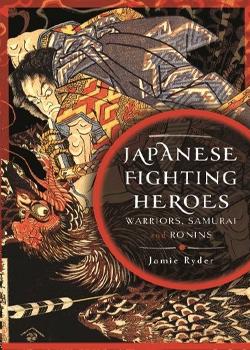Japanese Fighting Heroes: Warriors, Samurai and Ronins

By Jamie Ryder
Pen and Sword Books (2024)
ISBN-13: 978-1399057066
Review by Trevor Skingle
This multi-layered book by Jamie Ryder, the founder of Yamato magazine, is difficult to categorise but it certainly is informative and thoroughly enjoyable. It is bit like a series of reviews of personalities in their factual historical, and occasionally mythological, contexts. Covering pioneering trail blazers that include, amongst others, an actor, a writer, an ukiyo-e print maker, a poet, a suffragette, a philosopher, a film director, whisky, sake, and a tea-master as well as warriors, samurai and ronin this cast of characters are not ultimately defined or restricted by the book’s title. Championed by the author, they are nonetheless, alongside the warriors, samurai and ronin, some of the greatest exponents of their own area of expertise. Perhaps it is the intention of the book to expand the subject matter beyond the limits of its title. In that respect it tends towards avoiding playing it safe by rolling out the “usual suspects” that might otherwise appear in an entirely militaristically focused digest. Absent, for instance, is any mention of the perennial favourite Benkei, who came immediately to mind at the initial mention of Herculean samurai, and absent too is any reference to Yamamoto Tsunetomo's definitive Hagakure. The Book of the Samurai in the chapter on the interpretation of what it means to be samurai. There might be some subjects with which the reader may be more or less familiar, perhaps through films such as Inagaki Hiroshi’s Samurai trilogy (1954-1956) about the life of Miyamoto Musashi, Studio Ghibli’s The Tale of Princes Kaguya (2013), or Tanaka Mitsutoshi’s film Ask this of Rikyu (2013). Nevertheless, a fair amount of the time the author heads into less familiar yet fascinating territory with visits to characters that are probably not well known in the West.
Relatively brief and to the point, many chapters can be independently read and are summarised in a way that makes for interestingly interpretive and engaging reading. The occasional unfamiliar use of vernacular English terminology when translating Japanese terms (e.g. daimyos, ronins, samurais – plurals which in standard Japanese romaji are spelt daimyō, rōnin and samurai) can be forgiven as, contrary to potential accusations of linguistic relativism, it would seem as though the author is attempting to make the subject matter more accessible for Westerners with a general interest in Japan and Japanese culture rather than trying to satisfy the purist Japanophile cognoscenti.
Clearly the author knows and seems very familiar with his material. For instance, when it comes to sake there is no questioning the authenticity of the information that the author provides; he is, after all, a qualified sake sommelier (International kikisake-shi). However, for those readers with a knowledgeable curiosity and learned mind perhaps finely tuned into the subject matter, there are some omissions that had they been included might have developed, broadened and balanced the information provided on the subjects under the microscope.
For example, no mention is made of the pivotal Kinmokaku Gate incident at Daitokuji Temple in Kyoto in the chapter on the tea-master Sen-no-Rikyu (1522-1591), when Rikyu had a statue of himself placed in one of the upper stories of the gate. It is asserted that, having passed through the gate, the warlord Toyotomi Hideyoshi felt enraged that he had been deliberately humiliated by having to walk under the feet of Rikyu, and that it was this incident that prompted Hideyoshi to order Rikyu to commit seppuku. Whether this is myth or fact is a matter of conjecture, but context is taken into consideration when scrutinising other characters elsewhere in the book so why not here?
And the chapter which is a eulogy to the actress Sada Yacco or Sadayakko (1871-1946) might have included some of the more critical observations about her and her career and personality to create a more balanced perspective. The great Kabuki playwright Okamoto Kido in his book Talks on Meiji Era Theatre: Under the Lamp (1935) was less than complimentary about her, describing her as ‘pushy through and through’, whilst Jospeh L. Anderson’s Enter a Samurai: Kawakami Otojirō and Japanese Theatre in the West (2011) touches on her ‘devilry’ whilst on tour in the USA.
(Trigger warning) Though not for the fainthearted, there are a few standout chapters about the ukiyo-e printmaker Tsukioka Yoshitoshi (1839-1892), the author Akutagawa Ryonosuke (1892-1927) (the most harrowing account), and the film director Kurosawa Akira (1910-1998), that cover disturbing links between suicidal mental illness and creative genius, something which has affected more than fifty Japanese authors who have committed suicide in the 20th century (see the article by David Lester ‘Suicide in Japanese Writers', Asian Journal of Arts and Culture, 2022).
In the book Ryder states that he hasn’t yet been to Japan but being the publisher of the English language Yamato magazine has obviously spurred him to even greater efforts to further promote Japan and its culture to the English-speaking world with the publication of this book. For the reader with a general interest, he has managed to unwrap a little an intriguing, complex and fascinating culture and quite obviously relishes the subject matter to the extent that the chapters feel like delightfully prepared beckoning treats which may potentially open a gateway to a further, more in-depth, exploration.

